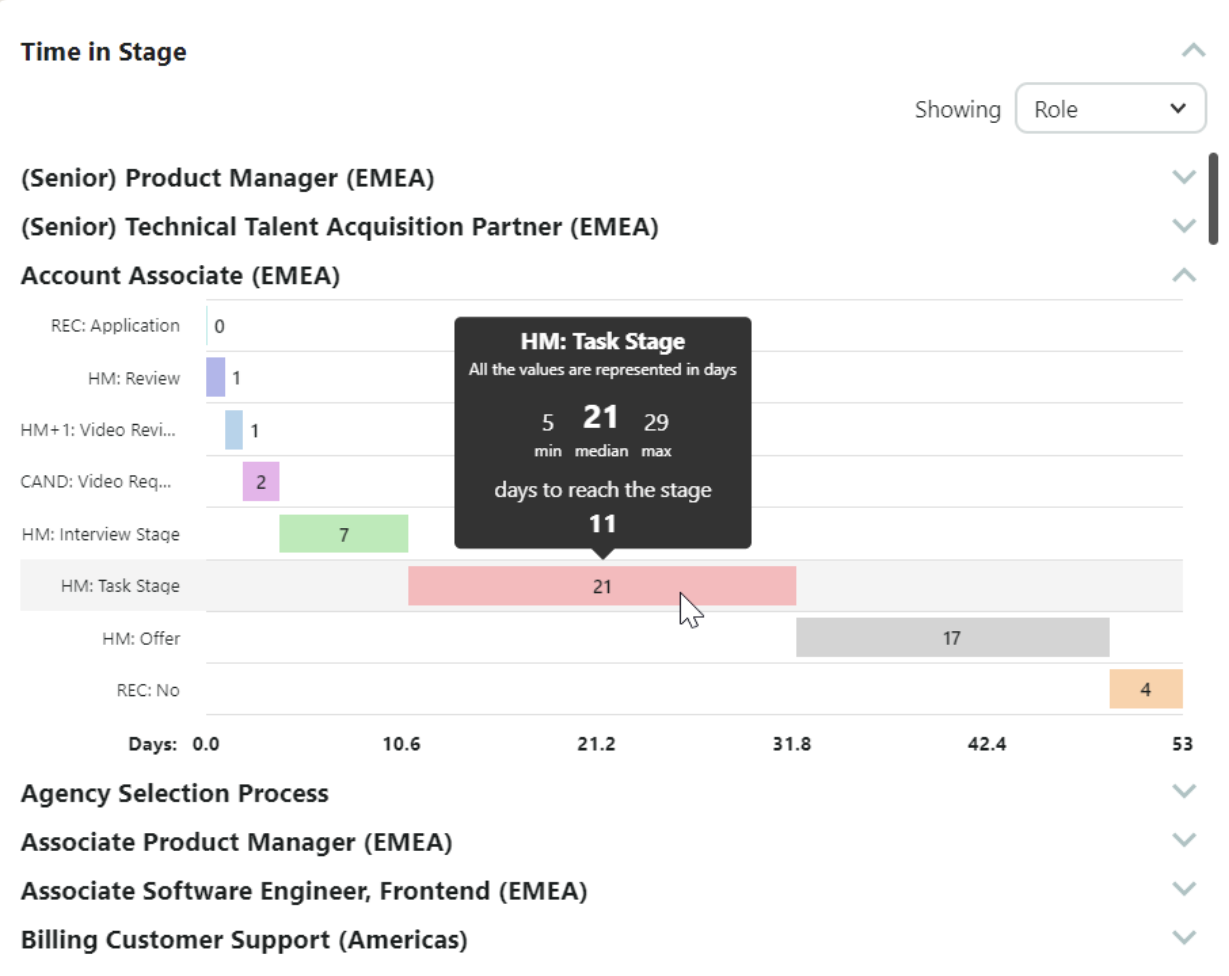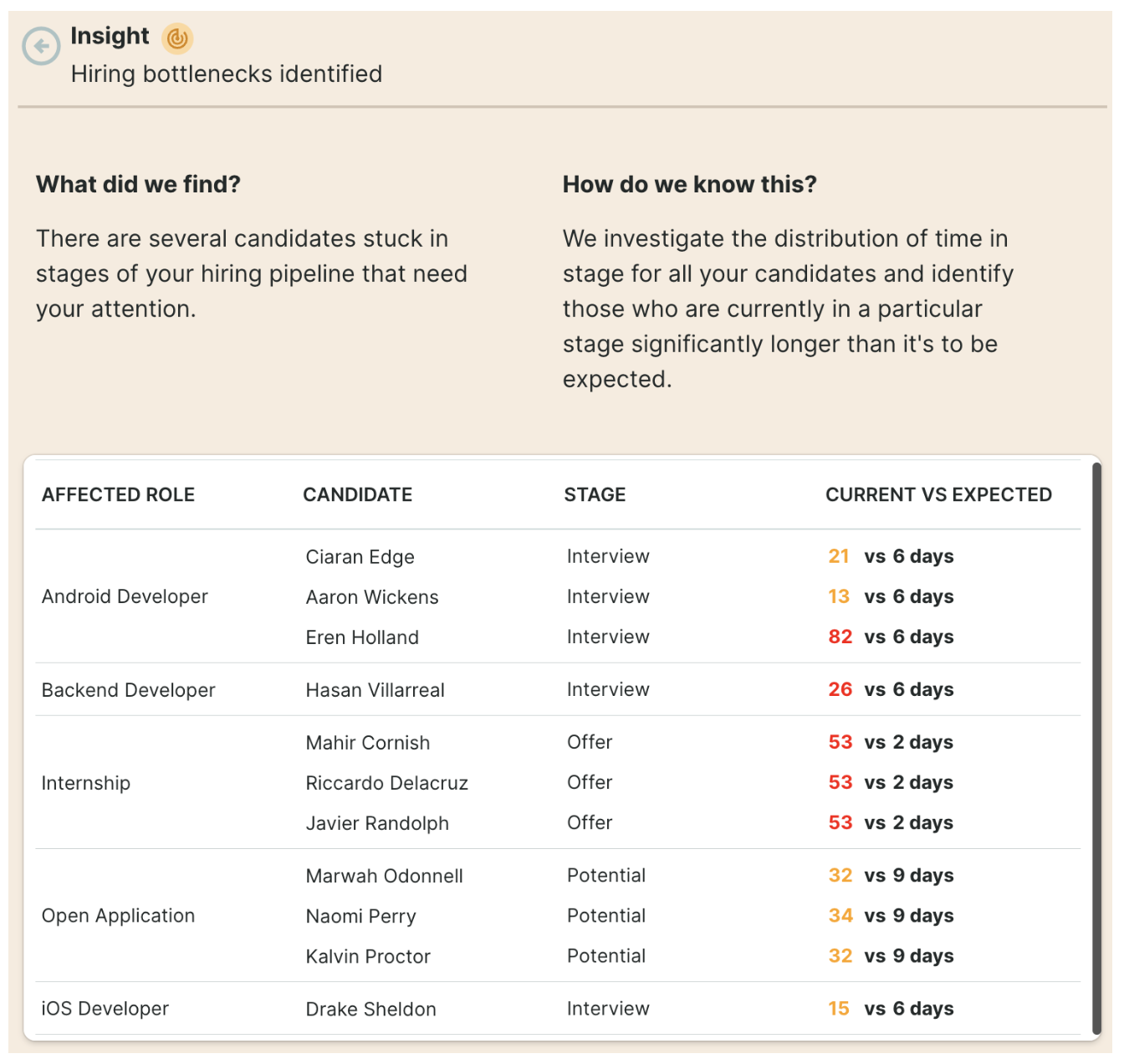Measuring Time to Hire, Fill, and Start helps you spot snags, boost hiring efficiency, and deliver a better candidate experience. Here’s how.
The time to fill a position is a measure that recruiters and HR managers want to keep an eye on, as it shows the (in)efficiency of the hiring process and helps identify bottlenecks or areas for improvement in recruitment and selection.
In this post, we focus on a new combination of metrics to track how long a candidate spends in the hiring process — Time to Hire, Fill, and Start — and factors that prolong hiring, as well as recommendations on how to make recruitment and selection more efficient. Read on to learn more.
What is Time to Hire, Fill, and Start and why should we track it?
Time to Hire, Fill, and Start refers to the time spent to close a vacancy and have a new employee start with the company. It has a direct impact on the company’s bottom line, through resources spent on the talent acquisition process (cost of hiring) and Time to Productivity of new hires (Quality-of-Hire) resulting in ROI.
There are several reasons why it’s important to measure and track Time to Hire, Fill, and Start.
First, it helps spot recruitment processes that take longer than expected and identify bottlenecks.
Second, uncovering slow and ineffective stages of hiring helps focus on areas that need improvement and lets you take targeted actions to streamline them and reduce the time and cost involved.
However, higher efficiency is not the only benefit of tracking and optimizing this metric.
A lengthy and complicated hiring process may result in a higher candidate dropout — top candidates may feel frustrated by the delays in the process and choose to pursue opportunities elsewhere.
Meanwhile, a shorter Time to Hire, Fill, and Start leads to increased productivity, as the organization can fill the vacant position and get a new employee up to speed more quickly — and it helps improve the candidate experience and enhance your employer brand.
How to measure Time to Hire, Fill, and Start?
Time to Hire, Fill, and Start comprises three components:
- Time to Hire
- Time to Fill
- Time to Start
Although at the first glance the three look similar, they refer to different timeframes within the hiring process.
Time to Hire
Time to Hire is the most common metric to estimate the time required to fill a vacant position. It measures the number of days between the candidate entering the recruiting funnel and accepting the job offer.
Time to Fill
Time to Fill is the time between the job opening and the moment the candidate accepts the job.
Compared to Time to Hire, this metric shows how long it takes to attract the right candidate to join the selection process, which gives you insights about the effectiveness of your recruitment efforts.
Time to Start
Time to Start is the most comprehensive of the three, as it measures the time between the creating the job position and the first day of work of the new hire.
To estimate the median Time to Hire, Time to Fill, or Time to Start for a specific role, calculate the median in days for all candidates who have been successfully hired for a specific role.
Similarly, you can measure the hiring time for specific departments, roles or for the entire organization.
Why does the hiring process take too long?
Understanding the difference between Time to Hire, Time to Fill, and Time to Start is crucial in identifying and addressing different challenges that may appear at different stages of the hiring process.
Time to Hire
Time to Hire shows how much time the successful candidate spent in the selection process.
When selection is getting longer than expected, it is worth checking whether the candidates are stuck in the hiring pipeline.
To do so, you can use the Time in Stage metric.

Compare the time expected to spend in each stage to the actual time that the candidates need to move from one stage to another. This way, you can identify the bottlenecks in the process and address them in an effective way.

Time to Fill
Compared to Time to Hire, Time to Fill adds information about the early stages of the recruitment process, i.e. how much time we spend reaching out to the right candidates.
If this takes longer than expected, have a closer look at the internal or external factors that influence recruiting.
For example, taking a long time to get the right applicants into the hiring pipeline may suggest room for improvement in your talent attraction strategy — perhaps you need to improve the clarity of job descriptions or change recruitment channels.
On the other hand, delays in the early recruitment stage may also be a sign that the demand for a specific role on the job market is larger than the pool of potential candidates qualified for this role.
Time to Start
Time to Start includes the last stage of hiring: the time between the moment the candidate accepts the offer and their first day of work — showing how long it takes the new hire to join the team.
The length of this stage gives insights into how you can plan the workload distribution depending on when you expect the new hire to join.
This metric depends on a number of factors, such as the role requirements (for example, relocation) or the new hire’s availability to start.
How to reduce Time to Hire, Fill, and Start?
Now that we’ve seen the importance of keeping Time to Hire, Fill, and Start at bay, let’s look at ways in which you can optimize it.
Set your hiring time targets
A good starting point is defining how quickly you want potential hires to move through each stage of the hiring process.
The average time to hire takes from two weeks to nearly two months, depending on the complexity of the role, the availability of qualified candidates, the number of applicants, or the industry and geographic area for which the job position has been created.
Some organizations may have a longer time to hire for certain roles due to the specialized nature of the job or a lack of qualified candidates in the job market.
On the other hand, organizations with a streamlined hiring process and a high volume of qualified candidates may be able to fill positions more quickly.
That’s why it’s important to set hiring time targets that are realistic for your context.
Setting and regularly reviewing and adjusting these goals helps ensure that your hiring efforts are effective and that you are able to bring on new team members timely.
Monitor your hiring funnel closely
Next, look into the details of the hiring funnel, rather than focusing on an overall number of days needed to cover a job position. Look into questions such as:
- What are the stages that take longer than expected?
- Are the challenges related to attracting candidates, or to moving them through the hiring pipeline?
- Where are the main bottlenecks?
With this information, you can address specific hiring issues that require attention, make your recruitment and selection more efficient, and get your team up to full strength more quickly.
Don’t overlook quality
Finally, remember that speed is not everything. Reducing the time to hire should never be a trade-off in terms of the quality of the candidates being considered.
By prioritizing speed over quality, the organization may end up hiring candidates who are not as qualified or a good fit for the role, which can lead to poor performance and a high employee turnover rate.
Also, a shorter hiring time should not affect the quality of the recruitment and selection process.
For example, it’s essential to ensure that with a shorter time of different stages, we still properly address diversity, equity, and inclusion in hiring.
How to work out Time to Hire, Fill, and Start automatically
When you’re focused on bringing top talent onboard, you likely have little time to manually calculate Time to Hire, Fill and Start metrics and identify hiring bottlenecks.
The good news is that with a people analytics platform, like Orgnostic, you can have these inefficiencies worked out for you – automatically.
In a just a few steps, you can connect all your data sources and get reliable Time to Hire, Fill and Start insights much sooner:
- Register on the Orgnostic Platform
- Connect your ATS into Orgnostic.
- Once your data is ready, head over to Story.
- Then, go to the Talent Acquisition chapter.
- There, head to the Time to Hire, Fill, and Start.
By getting Time to Hire, Fill, and Start automatically calculated for you, you can identify areas where recruitment and selection can be improved, and make hiring more efficient – faster.